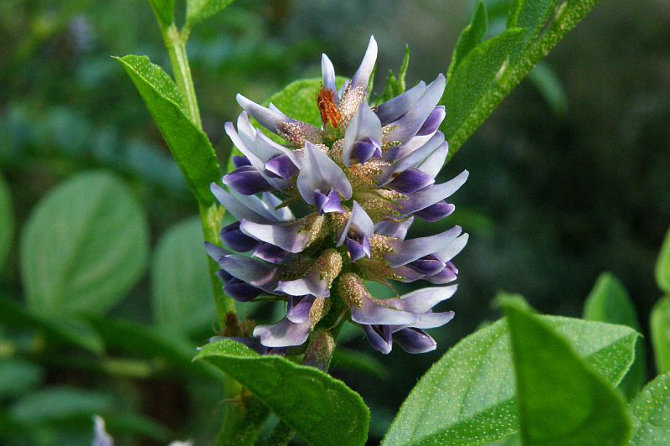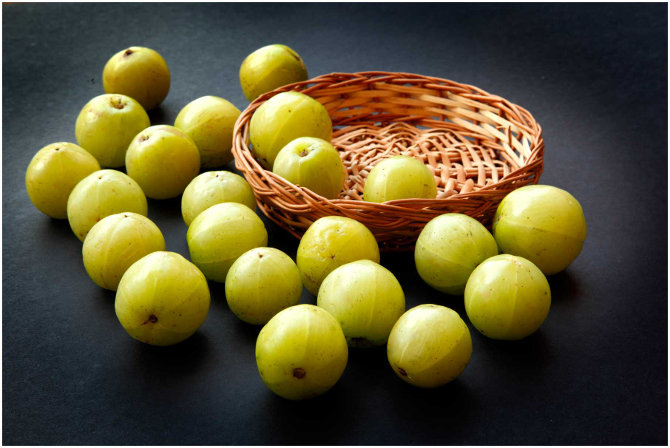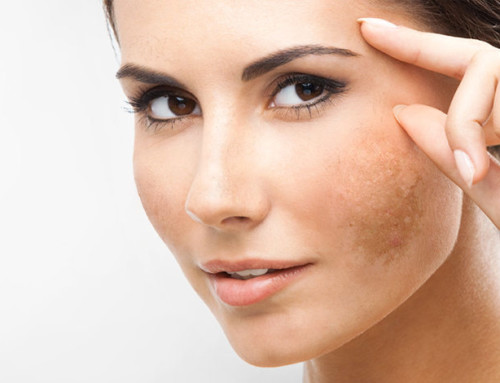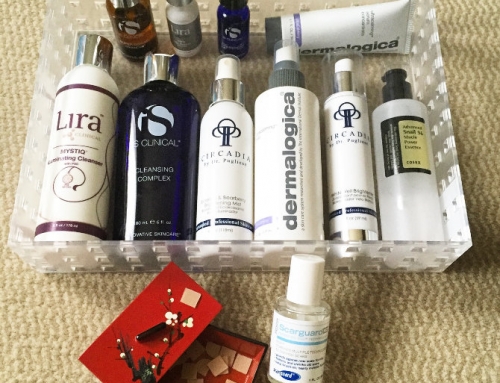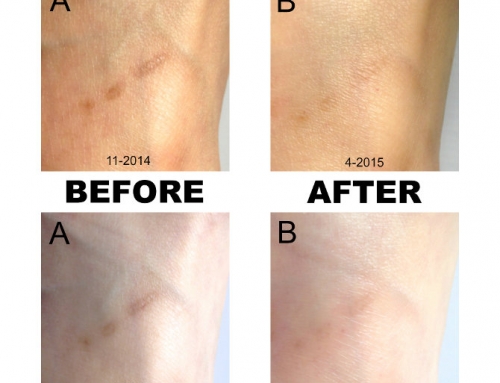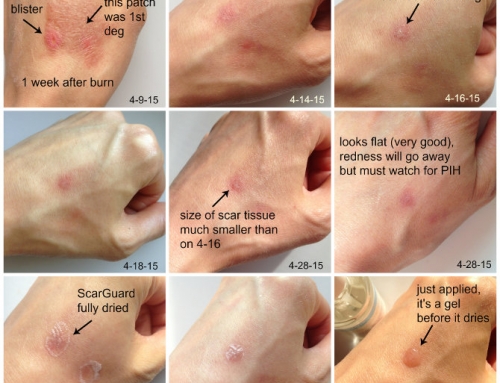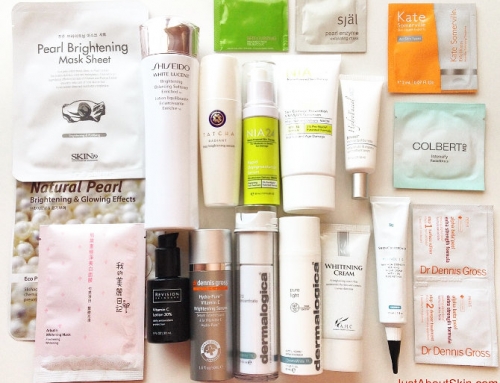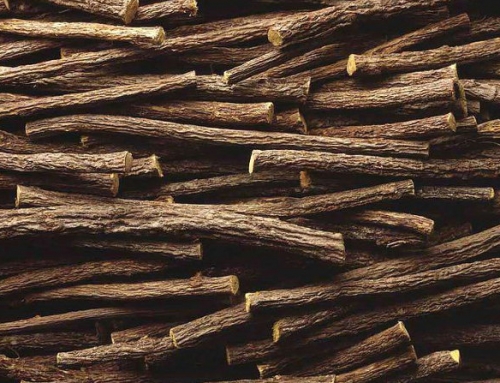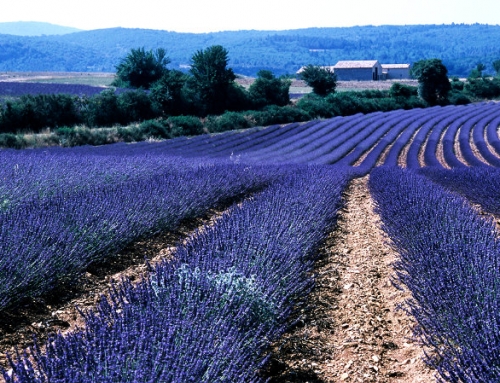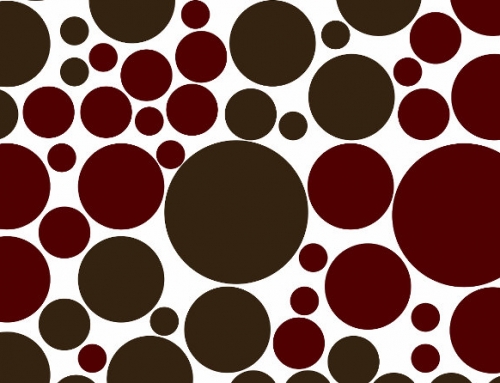Now that you have some idea of how pigment forms, let’s talk about how to treat hyperpigmentation.
Strategies for Treating Hyperpigmentation
There are various ways to treat hyperpigmentation (due to melanin):
1. Inhibit melanin production or deposits to prevent pigmentation from forming in the first place. Brightening ingredients work by blocking different steps of the melanin production pathway.
2. Remove melanin deposits by chemical means – exfoliating with AHA’s, getting chemical peels, using retinoids like Tretinoin or Retinol, brightening ingredients like Vitamin C, or a lightening agent like Hydroquinone. AHA’s and tretinoin/retinol also increase cell turnover, which help move the melanin out of skin faster.
3. Remove melanin deposits by mechanical means – ablative lasers which remove layers of skin, IPL (intense pulsed light) which shatters melanin pigment granules. Lasers are the best method for removing dermal pigment because they can penetrate all the way into the dermis.
4. Slow down melanin production with injections (key ingredient is glutathione).
The third and fourth methods require seeing a dermatologist. In this article, I will focus on the first two methods – using skin care products containing lightening and brightening ingredients.
Lightening vs Brightening vs Whitening
Before I proceed, it’s important to define lightening, brightening, and whitening, because these terms are thrown around a lot and used interchangeably.
‘Lightening’ is a term that can only be used in product claims when the active ingredient is a drug approved for skin lightening. There is only one in the U.S. at this moment – Hydroquinone.
All other ingredients must be called ‘brightening’ ingredients.
Similarly, ‘whitening’ cannot be used in product claims. But you will often find the term ‘whitening’ in the product names of Asian skin care lines.
Most Common Lightening & Brightening Ingredients
Here are the most common ingredients used in skin care products.
Legal Lightening Agent (in the U.S.):
- Hydroquinone (less than 2% for non-prescription, more than 2% must be acquired by prescription in the U.S.)
Similar to Hydroquinone:
- Kojic Acid (similar in structure to Hydroquinone, found in some mushrooms)
- Arbutin (glycosylated form of Hydroquinone, more gentle, found in Bearberry, Paper Mulberry, Blueberry, Cranberry)
- Mequinol (ether of Hydroquinone, used with Tretinoin, by Rx only)
Other Plant-Derived Brighteners:
- Licorice Root (botanical Latin name: Glycyrrhiza Glabra, may see this as Glycyrrhizate on an ingredient list)
- Glabridin (main oil-soluble compound found in licorice root)
- Pine Bark (botanical Latin name: Pinus Pinaster)
- Pycnogenol (main compound found in pine bark)
- Indian Gooseberry (botanical Latin name: Phyllanthus emblica)
- Willow Herb (botanical Latin name: Epilobium angustifolium, one of the sources of Salicylic Acid)
- Cucumber
Exfoliating Ingredients:
- Azelaic Acid
- Lactic Acid
- Phytic Acid
- Glycolic Acid
- Salicylic Acid
- Trichloroacetic (TCA)
- Enzymes (e.g. papain, bromelain)
Other Chemicals:
- Retinoids (e.g. Retinol, Tretinoin)
- Vitamin C
- Niacinamide
- Glucosamine
- Soy (fractionated, without the estrogenic fractions, estrogen worsens melasma)
- Resorcinol
- Certain Peptides (e.g. Nonapeptide-1, Oligopeptide-68, Oliogpeptide-34, Oligopeptide-51)
Which Ingredients Are Effective?
There are no definitive answers on which ingredients are most effective. But one thing is clear. To treat hyperpigmentation effectively, a blend of brightening ingredients are needed.
The pigmentation process is a long sequence of steps. Brightening ingredients work by blocking different steps. The more steps that are blocked, the better. And the earlier the steps are blocked, the better.
Here are some general comments on the ingredients listed above:
- Hydroquinone – most effective for lightening but controversial (see below)
- Kojic Acid – effective but controversial (see below), has anti-bacterial properties
- Licorice – strong tyrosinase inhibitor, 25x better than Kojic Acid, also anti-inflammatory and antioxidant
- Paper Mulberry – not a strong tyrosinase inhibitor compared with other ingredients but has low risk for irritation and is anti-inflammatory
- Azelaic acid – inhibits the growth of melanocytes (the cells that produce pigment), a tyrosinase inhibitor, mild exfoliant, anti-bacterial
- Lactic acid – a tyrosinase inhibitor, also hydrating, exfoliating, and anti-bacterial
- AHA’s & Enzymes – only exfoliate skin, increasing cell turnover and ‘washing’ melanin out of skin faster, but do not target root cause of pigmentation
- Vitamin C (L-Ascorbic acid) – good for providing overall radiance and brightening
- Phytic Acid – works by blocking oxidation in the melanogenesis process
- Retinoids – suppress melanosome transfer during the pigmentation process, increases cell turnover and exfoliates skin so that melanin is removed from skin faster
Controversial
Hydroquinone
Hydroquinone is a controversial ingredient. The professional skincare community is divided about it. Some skincare professionals and manufacturers believe it poses some health risks and is potentially irritating to skin. The dermatology community, FDA, other skincare professionals and manufacturers believe it is safe for use on skin.
The objections and concerns about Hydroquinone are:
- effective but can be irritating at >2% concentration; >4% may be cytotoxic (HQ causes apoptosis in melanocyte cells and may cause damage in neighboring cells)
- can lead to exogenous ochronosis (an increase in pigmentation that is serious and hard to treat, skin of color is more at risk) or hypopigmentation
- repigmentation may occur after treatment is discontinued in skin of color
- some people are allergic (as many as one third of the population could be)
- may cause contact dermatitis in some
- may cause photosensitivity with extended use
- not recommended for use in large areas of skin
- widely thought to have carcinogenic effects, but the studies that are cited are based on tests with high doses in mice; the FDA and dermatology community believe hydroquinone is safe for use
- more tightly regulated in other countries outside U.S. (not actually banned in Europe or Canada, contrary to popular belief)
Kojic Acid
- comparable in effectiveness to hydroquinone but has high sensitizing potential, can be an irritant and cause contact dermatitis
- usually used in concentrations of 1-4%
- banned in Japan, Sweden, and Switzerland
New Botanical Brightening Ingredients
New botanical ingredients (phytochemicals) are discovered and added to skin care products every day. Have you noticed the number of plant-based ingredients appearing on ingredient lists in recent years? The telltale sign are Latin names. Botanicals are typically listed by their Latin name, not by their plain English name.
Here are just a few to give you an idea:
- Ascophyllum nodosum (a seaweed)
- Aspergillus ferment (a mold)
- Ferula foetida (giant fennel)
- Mitracarpus scaber (an African weed)
- Nasturtium officinale (water cress)
- Palmaria palmata (red algae)
- Rumex crispus (yellow dock)
- Salvia miltiorrhiza (Chinese sage)
- Saxifrage sarmentosa (strawberry begonia)
- Sophira angustifolia (a tree)
There Is No Single Magic Ingredient, You Need A Blend
Stopping pigmentation from being formed and deposited requires multiple ingredients, not just one.
This is because the melanin production process is a cascade of many steps. Ingredients work by interrupting the cascade at different steps.
The best approach to stop hyperpigmentation is to use a blend of ingredients that can block multiple steps. The more steps that are blocked, the better.
What Products Should You Use?
There are a few things you can try. Unfortunately, there is no single, magical answer. You’ll have to experiment a bit with different ingredients.
1). Use a spot treatment product on areas where you have discrete spots or small regions of discolorations. When you evaluate spot treatments, look at the ingredient list carefully. Some spot treatment products are nothing more than glorified Vitamin C or retinol serums. There is nothing wrong with that (they may be very good anti-aging serums), but the amount of ‘lightening’ will be limited if they contain few other brightening ingredients.
2.) Look for a blend of brightening ingredients, not just one.
3). Look for licorice in your serums and moisturizers. Licorice is a great ingredient, not just for brightening. It is a powerful anti-inflammatory, which helps control post-inflammatory hyperpigmentation as well as chronic inflammation (which gradually ages skin). It is also a strong antioxidant. Unfortunately, licorice isn’t easy to formulate with, so it is not common in less expensive skin care products.
4). Exfoliate regularly with a chemical exfoliant, such as an AHA or enzyme (except if you have very sensitive or reactive skin, in which case you should probably skip the chemical exfoliation altogether). While it won’t tackle the root cause of the pigmentation, it can help lighten the areas. If you have a darker skin tone, be careful with AHA exfoliants and strong peels, which can cause post-inflammatory pigmentation (read these exfoliation precautions).
5). Use a serum containing retinol or Vitamin C (or both). Alternatively, find a moisturizer that contains these ingredients. If you are working on anti-aging, then you should be incorporating Vitamin C and retinol into your skin care routine regardless (unless your skin is sensitive to them).
Don’t Forget Sunscreen
Wearing sunscreen and staying out of the sun is a must. Especially if you have melasma, which is hard to treat and can take a long time to fade.
Remember sun stimulates melanin production. So if you’re not shielding your skin, then the sun will just reverse any progress you’ve made with topical treatments or cosmetic procedures.
Sun may also cause photosensitivity in recently exfoliated skin. So, if your spot treatment product or brightening serum contains retinol or an AHA, you need to wear sunscreen over it.
In addition to sunscreen, wear a hat. A wide brim (3-4″) and fabric with tight weave is best.
How Long Does It Take?
If the pigmentation is epidermal in nature, it takes about 14-20 days for melanin to travel from the Basal layer of the skin (the lowest layer of the epidermis) to the Stratum Corneum (outermost layer of skin). But it can take up to 45 days. The older you are, the longer it takes (because cell turnover slows down with age).
If the pigmentation is dermal in nature, it takes much longer and is not likely to respond to most brightening ingredients (because most ingredients can’t reach the dermis). In this case, that pigmentation is best treated by lasers.
Cover photo of this article is the Licorice plant, Glycyrrhiza glabra.
Related Articles:

